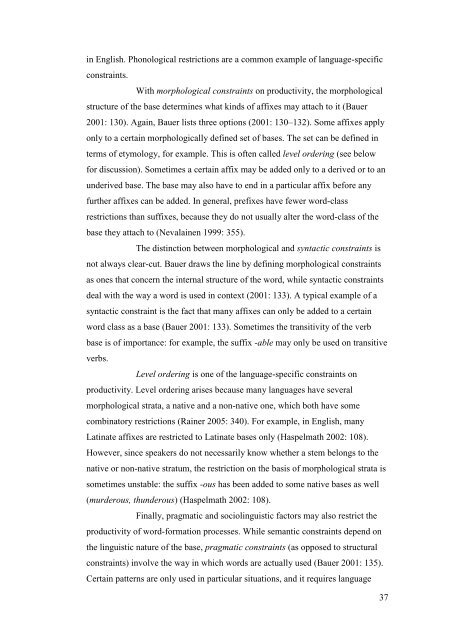The morphological productivity of selected ... - Helda - Helsinki.fi
The morphological productivity of selected ... - Helda - Helsinki.fi
The morphological productivity of selected ... - Helda - Helsinki.fi
You also want an ePaper? Increase the reach of your titles
YUMPU automatically turns print PDFs into web optimized ePapers that Google loves.
in English. Phonological restrictions are a common example <strong>of</strong> language-speci<strong>fi</strong>c<br />
constraints.<br />
With <strong>morphological</strong> constraints on <strong>productivity</strong>, the <strong>morphological</strong><br />
structure <strong>of</strong> the base determines what kinds <strong>of</strong> af<strong>fi</strong>xes may attach to it (Bauer<br />
2001: 130). Again, Bauer lists three options (2001: 130–132). Some af<strong>fi</strong>xes apply<br />
only to a certain <strong>morphological</strong>ly de<strong>fi</strong>ned set <strong>of</strong> bases. <strong>The</strong> set can be de<strong>fi</strong>ned in<br />
terms <strong>of</strong> etymology, for example. This is <strong>of</strong>ten called level ordering (see below<br />
for discussion). Sometimes a certain af<strong>fi</strong>x may be added only to a derived or to an<br />
underived base. <strong>The</strong> base may also have to end in a particular af<strong>fi</strong>x before any<br />
further af<strong>fi</strong>xes can be added. In general, pre<strong>fi</strong>xes have fewer word-class<br />
restrictions than suf<strong>fi</strong>xes, because they do not usually alter the word-class <strong>of</strong> the<br />
base they attach to (Nevalainen 1999: 355).<br />
<strong>The</strong> distinction between <strong>morphological</strong> and syntactic constraints is<br />
not always clear-cut. Bauer draws the line by de<strong>fi</strong>ning <strong>morphological</strong> constraints<br />
as ones that concern the internal structure <strong>of</strong> the word, while syntactic constraints<br />
deal with the way a word is used in context (2001: 133). A typical example <strong>of</strong> a<br />
syntactic constraint is the fact that many af<strong>fi</strong>xes can only be added to a certain<br />
word class as a base (Bauer 2001: 133). Sometimes the transitivity <strong>of</strong> the verb<br />
base is <strong>of</strong> importance: for example, the suf<strong>fi</strong>x -able may only be used on transitive<br />
verbs.<br />
Level ordering is one <strong>of</strong> the language-speci<strong>fi</strong>c constraints on<br />
<strong>productivity</strong>. Level ordering arises because many languages have several<br />
<strong>morphological</strong> strata, a native and a non-native one, which both have some<br />
combinatory restrictions (Rainer 2005: 340). For example, in English, many<br />
Latinate af<strong>fi</strong>xes are restricted to Latinate bases only (Haspelmath 2002: 108).<br />
However, since speakers do not necessarily know whether a stem belongs to the<br />
native or non-native stratum, the restriction on the basis <strong>of</strong> <strong>morphological</strong> strata is<br />
sometimes unstable: the suf<strong>fi</strong>x -ous has been added to some native bases as well<br />
(murderous, thunderous) (Haspelmath 2002: 108).<br />
Finally, pragmatic and sociolinguistic factors may also restrict the<br />
<strong>productivity</strong> <strong>of</strong> word-formation processes. While semantic constraints depend on<br />
the linguistic nature <strong>of</strong> the base, pragmatic constraints (as opposed to structural<br />
constraints) involve the way in which words are actually used (Bauer 2001: 135).<br />
Certain patterns are only used in particular situations, and it requires language<br />
37
















